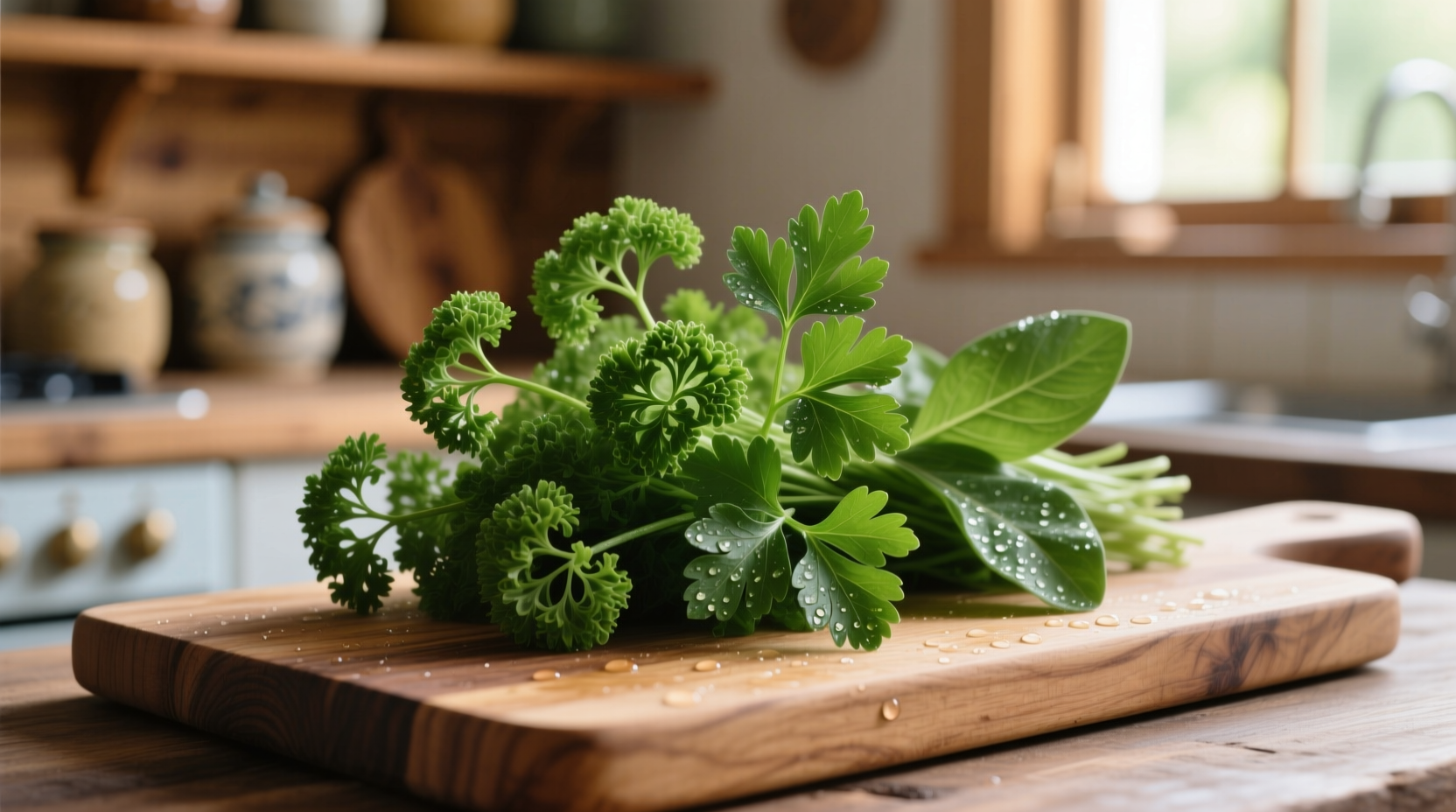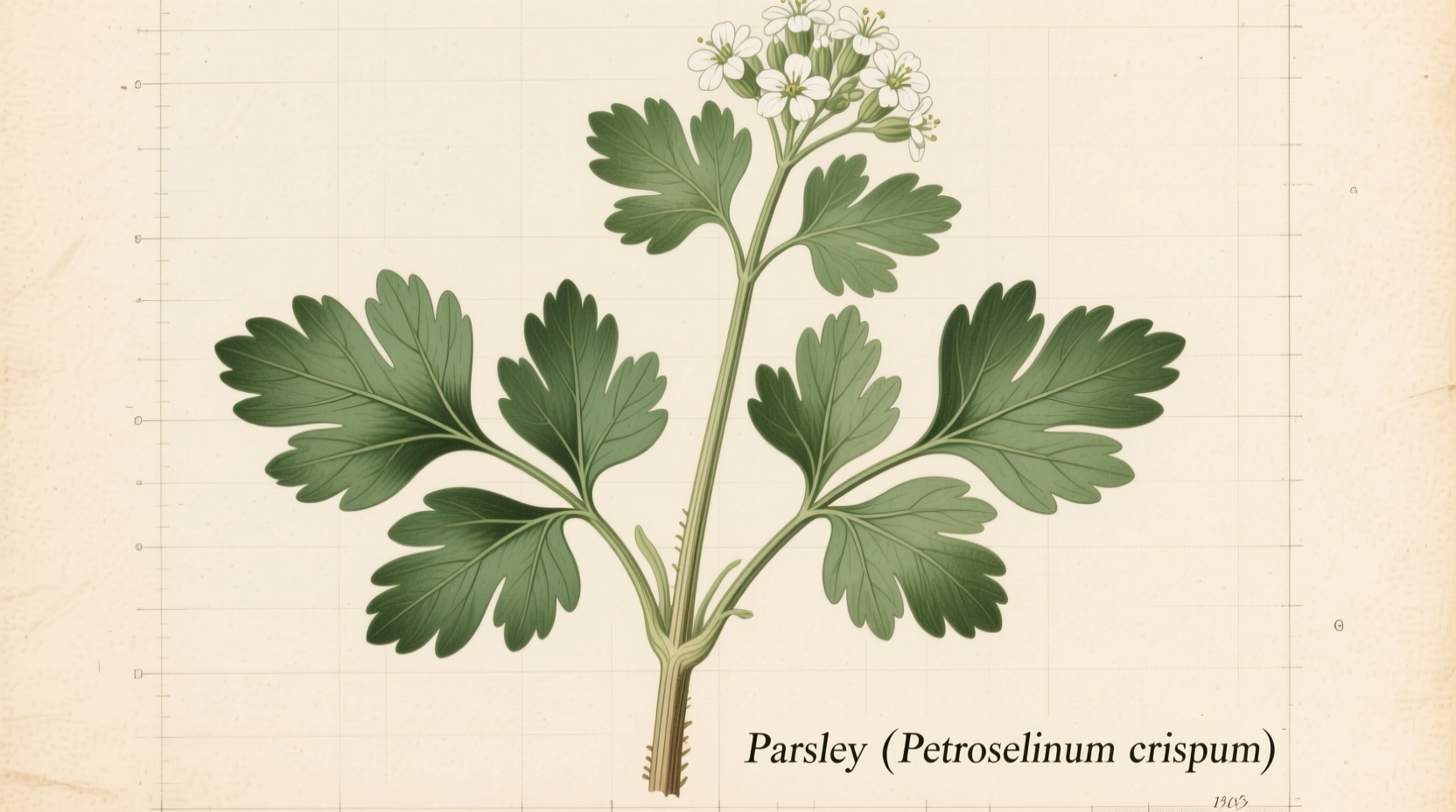Parsley (Petroselinum crispum) is a biennial herb in the Apiaceae family, valued globally as both a culinary staple and medicinal plant. This vibrant green herb comes in two primary varieties—curly leaf and flat-leaf (Italian)—each offering distinct flavor profiles and culinary applications. Native to the Mediterranean region, parsley provides essential vitamins K, C, and A while adding fresh, slightly peppery notes to dishes. Understanding its botanical characteristics, historical significance, and practical uses transforms how home cooks and chefs incorporate this versatile herb into everyday cooking.
Recognizing Parsley: Visual Identification Guide
Before using parsley, proper identification is crucial—especially since it closely resembles potentially toxic plants like hemlock. Fresh parsley features bright green, triangular-shaped leaves growing in clusters on slender stems. The herb emits a clean, slightly peppery aroma when crushed. Curly parsley has ruffled, tightly curled leaves, while flat-leaf varieties display smooth, pointed foliage similar to cilantro but with a darker green hue and less citrusy scent.

From Ancient Remedy to Culinary Essential: Parsley's Journey
Parsley's story spans millennia, evolving from symbolic decoration to kitchen necessity. Ancient Greeks crowned athletic victors with parsley wreaths, associating it with death and rebirth. Romans later adopted it as a breath freshener and plate garnish. During the Middle Ages, European monks cultivated parsley in monastery gardens for both culinary and medicinal purposes. The herb gained widespread popularity in the 16th century when French and Italian chefs began incorporating it into signature dishes, establishing parsley as a foundational element in European cuisine.
| Variety | Flavor Profile | Best Culinary Uses | Storage Duration |
|---|---|---|---|
| Curly Parsley | Milder, slightly grassy | Garnishes, soups, stews | 1-2 weeks refrigerated |
| Flat-Leaf (Italian) | Bolder, earthier, more robust | Sauces, marinades, Mediterranean dishes | 7-10 days refrigerated |
| Japanese Parsley (Mitsuba) | Celery-like with citrus notes | Asian cuisine, salads, garnishes | 3-5 days refrigerated |
Maximizing Flavor: Practical Culinary Applications
Professional chefs consistently recommend flat-leaf parsley for cooking due to its superior flavor retention and easier chopping. Reserve curly parsley for finishing dishes where visual appeal matters most. When incorporating parsley into recipes, add it during the final minutes of cooking to preserve its vibrant color and fresh flavor. The herb's natural compounds pair exceptionally well with garlic, lemon, and olive oil—creating the foundation for classic preparations like gremolata, chimichurri, and persillade.
Avoid common mistakes like using dried parsley as a substitute for fresh in prominent roles. While dried parsley maintains some nutritional value, it lacks the aromatic complexity of fresh leaves. For optimal results, store fresh parsley with stems in a glass of water (like flowers) covered with a plastic bag in the refrigerator. This technique, validated by agricultural studies from the University of California Cooperative Extension, extends freshness by up to 50% compared to conventional storage methods.
Nutritional Powerhouse: Science-Backed Health Benefits
Beyond its culinary value, parsley delivers impressive nutritional benefits. Just one-quarter cup (10g) of fresh parsley provides:
- 547% of the daily recommended intake of vitamin K
- 14% of vitamin C requirements
- 12% of daily vitamin A needs
- Significant amounts of folate and iron
Research published in the Journal of Agricultural and Food Chemistry confirms parsley contains apigenin, a flavonoid with demonstrated anti-inflammatory properties. The herb's high chlorophyll content also contributes to natural breath freshening and detoxification support. Nutritionists recommend incorporating parsley into daily meals not just for flavor, but as part of a nutrient-dense eating pattern.
Growing Your Own: Simple Cultivation Tips
Home gardeners can successfully grow parsley in containers or garden beds with minimal effort. The herb prefers partial sun (4-6 hours daily) and well-draining soil with consistent moisture. Unlike many herbs, parsley tolerates cooler temperatures, making it suitable for spring and fall cultivation in most climates. For best results, sow seeds directly into soil as parsley develops a long taproot that doesn't transplant well. Expect germination in 2-4 weeks, with harvestable leaves appearing 70-90 days after planting.
When harvesting, cut outer stems first to encourage continuous growth throughout the season. Morning harvesting yields the most flavorful and aromatic leaves, as essential oils concentrate before daytime heat. Remember that parsley is a biennial plant—it typically produces leaves in the first year and flowers in the second before completing its life cycle.
FAQ: Common Parsley Questions Answered
Can I substitute cilantro for parsley in recipes?
While visually similar, cilantro has a distinct citrus flavor that doesn't work as a direct substitute. In Mediterranean dishes requiring parsley's mild pepperiness, cilantro's strong flavor will alter the intended taste profile. However, in Latin American or Southeast Asian cuisines, the two herbs often complement rather than replace each other.
Why does my parsley turn yellow quickly?
Yellowing typically indicates improper storage or overwatering. Store parsley with stems in water, covered loosely with a plastic bag in the refrigerator. Change the water every two days. In gardens, yellowing often signals poor drainage or excessive nitrogen—parsley prefers balanced, moderate feeding.
Is parsley safe for pets?
While small amounts of parsley are generally safe for dogs and cats, the ASPCA warns that large quantities may cause photosensitivity in some animals. The herb contains furanocoumarins that can increase sun sensitivity. Consult your veterinarian before regularly adding parsley to pet food.











 浙公网安备
33010002000092号
浙公网安备
33010002000092号 浙B2-20120091-4
浙B2-20120091-4